
Jacques Becker was a French film director and screenwriter. His films, made during the 1940s and 1950s, encompassed a wide variety of genres, and they were admired by some of the filmmakers who led the French New Wave movement.

We Are All Murderers is a 1952 French-Italian crime drama film written and directed by André Cayatte and starring Marcel Mouloudji, Raymond Pellegrin and Claude Laydu. It was shot at the Boulogne Studios in Paris. The film's sets were designed by the art director Jacques Colombier. It tells the story of René, a young man from the slums, trained by the French Resistance in World War II to kill Germans. He continues to kill long after the war has ended, as it is all he knows. It was entered into the 1952 Cannes Film Festival and won the Special Jury Prize.

Sylvia Bataille was a French actress of Romanian-Jewish descent. When she was twenty, she married the writer Georges Bataille with whom she had a daughter, the psychoanalyst Laurence Bataille (1930–1986). Georges Bataille and Sylvia separated in 1934 but did not divorce until 1946. Starting in 1938, she was a companion of the psychoanalyst Jacques Lacan with whom, in 1941, she had a daughter, Judith. Sylvia Bataille married Jacques Lacan in 1953.

Raymond Rouleau was a Belgian actor and film director. He appeared in more than 40 films between 1928 and 1979. He also directed 22 films between 1932 and 1981. Rouleau studied at the Royal Conservatory of Brussels, where he met Tania Balachova. They emigrated to Paris together and collaborated with a variety of directors at the cutting edge of French theatre, including Charles Dullin and Gaston Baty. They married in France and separated in 1940. He subsequently married the actress Françoise Lugagne.
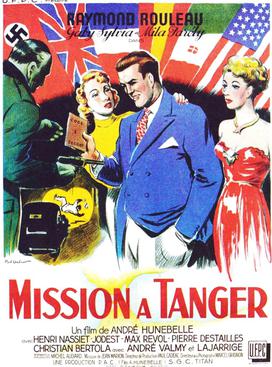
Mission in Tangier is a 1949 French spy thriller film directed by André Hunebelle and starring Raymond Rouleau, Gaby Sylvia and Mila Parély. It was the first in the trilogy of films featuring dashing reporter Georges Masse, and was followed in 1950 by Beware of Blondes. It was shot at the Billancourt Studios in Paris. The film's sets were designed by the art director Lucien Carré. It has been described as a French film noir.
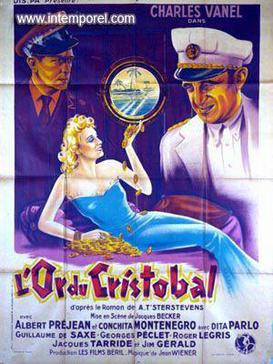
Cristobal's Gold is a 1940 French drama film directed by Jean Stelli and Jacques Becker and starring Charles Vanel, Conchita Montenegro and Albert Préjean. Jean Renoir helped the original director, Jacques Becker, prepare the film and worked on the script, before Becker quit after three weeks and was replaced by Jean Stelli. The film is based on a novel by Albert t'Serstevens. It was shot at the Boulogne Studios in Paris and the Victorine Studios in Nice with location shooting taking place around Villefranche-sur-Mer. The film's sets were designed by the art director Eugène Lourié.
Jacques Companeez was a Russian Jewish émigré screenwriter in Paris.

The Weaker Sex is a 1933 French comedy film directed by Robert Siodmak and starring Mireille Balin, Victor Boucher and Pierre Brasseur. It was based on a 1929 stage farce of the same name by Édouard Bourdet.
Maxime Fabert, real name Robert Émile Jaillon, was a French stage and film actor. Maxime Fabert managed the Theater of the Comédie-Wagram from 1946 to 1962.
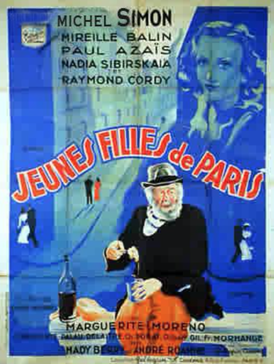
Girls of Paris is a 1936 French comedy drama film directed by Claude Vermorel and starring Michel Simon, Mireille Balin and Paul Azaïs. The film's sets were designed by the art director Jean Douarinou.

Doctor Laennec is a 1949 French historical drama film directed by Maurice Cloche and starring Pierre Blanchar, Saturnin Fabre and Mireille Perrey. It portrays the work of René Laennec, the inventor of the stethoscope.

The Honourable Catherine is a 1943 French comedy film directed by Marcel L'Herbier and starring Edwige Feuillère, Raymond Rouleau and André Luguet. Some of the film's final scenes were directed by an uncredited Jacques de Baroncelli. It was shot at the Buttes-Chaumont Studios in Paris. The film's sets were designed by the art director André Barsacq.
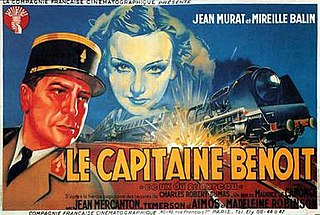
Captain Benoit is a 1938 French thriller film directed by Maurice de Canonge and starring Jean Murat, Mireille Balin and Madeleine Robinson. The film's sets were designed by the art director Lucien Aguettand. It was the fourth and final entry in a series of films featuring Captain Benoît, a member of the Deuxième Bureau, following Second Bureau, Wolves Between Them and A Man to Kill.

Pierre and Jean is a 1943 French drama film directed by André Cayatte and starring Renée Saint-Cyr, Noël Roquevert and Jacques Dumesnil. It is based on the novel Pierre and Jean by Guy de Maupassant. It was shot at the Billancourt Studios and Neuilly Studios in Paris and on location in Gournay-sur-Marne. The film's sets were designed by the art director Andrej Andrejew.

The Orderly is a 1933 French drama film directed by Victor Tourjansky and starring Marcelle Chantal, Jean Worms and Fernandel. It is based on Guy de Maupassant's story L'ordonnance. Tourjanski had already filmed the same story in 1921. It was shot at the Joinville Studios of Pathé-Natan in Paris. The film's sets were designed by the art director Serge Piménoff. It was voted amongst the most popular films of the year by readers of the Pour Vous magazine.

Beautiful Days is a 1935 French comedy film directed by Marc Allégret and starring Simone Simon, Jean-Pierre Aumont and Raymond Rouleau. The film's sets were designed by the art directors Jean d'Eaubonne and Lazare Meerson.

Threats is a 1940 French drama film directed by Edmond T. Gréville and starring Mireille Balin, John Loder, Ginette Leclerc and Erich von Stroheim. Gréville began production on the film shortly after the Munich Agreement of September 1938. It was shot at the François 1er Studios in Paris. The film's sets were designed by the art director Lucien Jaquelux.
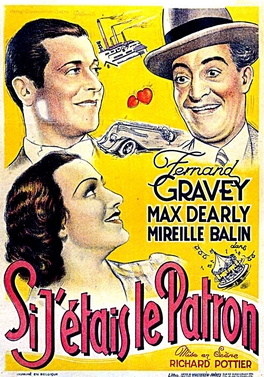
If I Were Boss is a 1934 French comedy film directed by Richard Pottier and starring Fernand Gravey, Max Dearly and Mireille Balin. The film's sets were designed by the art director Jacques Krauss. Thr depiction of a struggling business has been regarded as a metaphor for the wider state of French industry at the height of the Great Depression. It was produced the same year as a number of financial scandals hit French firms.
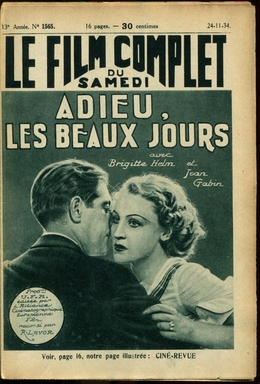
Goodbye, Beautiful Days is a 1933 French-German comedy film directed by André Beucler and Johannes Meyer and starring Brigitte Helm, Jean Gabin and Ginette Leclerc. It was shot at the Babelsberg Studios in Berlin and on location in Biarritz and San Sebastian. The film's sets were designed by art directors Erich Kettelhut and Max Mellin. It was co-produced and distributed by L'Alliance Cinématographique Européenne, the French subsidiary of the German company UFA. A separate German-language version Happy Days in Aranjuez with Helm appearing in both films.

The Woman I Loved Most is a 1942 French drama film directed by Robert Vernay and starring Arletty, Mireille Balin and Lucien Baroux. It was shot at the Cité Elgé Studios in Occupied Paris. The film's sets were designed by the art director René Renoux.


















